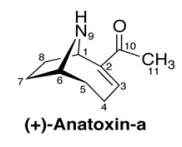Home » Chemistry Degree Programs at Western Oregon University » Student Activities » Chemistry Corner » Freshwater Harmful Algal Blooms (HABs) of The Pacific Northwest » Anabaena
MenuChemistry Corner
Anabaena/Anatoxin-a
Anabaena blooms, sometimes call dolichospermum, come in a few different subspecies that can create cyanotoxins, microcystins (learn more under the microcystis page) and anatoxin-a. Anabaena itself is filamentous, meaning threadlike, and found in single rows that are either straight, curled, or coiled. Individual cells are beadlike, making the shape most common to a string of beads. The colors of Anabaena range from blue-green to yellow-green, as seen in the photos. Anabaena will be found about the water as the bacteria itself contains gas vesicles. This will be more common in nitrogen rich waterbodies.
Anatoxin-a is a neurotoxin that is very soluble in water. According to the EPA it binds to acetylcholine receptors and neuromuscular nicotinic receptors, giving it neurological effects. The structure, seen to the side, is similar to cocaine, and has a molecular formula of C10H15NO.
Specific signs of anatoxin poisonings include tingling, burning, numbness, drowsiness, incoherent speech, salvation, and respiratory failure and paralysis that leads to death.
Sources
Oregon Department of Environmental Quality. Anabaena SP. [Image File]. In Harmful Algae Bloom (HAB) Strategy. https://www.oregon.gov/deq/wq/Pages/Harmful-Algal-Blooms.aspx
Carpenter, Kurt. Microscopic Views of a Colony [Image File]. In Upstream Factors Affection Tualatin River Algae – Tracking the 2008 Anabaena Algae Bloom to Wapato Lake, Oregon. https://pubs.usgs.gov/sir/2015/5178/sir20155178.pdf
Carpenter, Kurt. Filament of Anabaena [Image File]. In Upstream Factors Affection Tualatin River Algae – Tracking the 2008 Anabaena Algae Bloom to Wapato Lake, Oregon. https://pubs.usgs.gov/sir/2015/5178/sir20155178.pdf
United States Environmental Protection Agency. Health Effects from Cyanotoxins. https://www.epa.gov/cyanohabs/health-effects-cyanotoxins
Oregon Department of Environmental Quality. Harmful Algae Bloom (HAB) Strategy. https://www.oregon.gov/deq/wq/Pages/Harmful-Algal-Blooms.aspx
Reactions. What Makes Blue-Green Algae Dangerous? – Speaking of Chemistry [Video File]. Youtube, June 2, 2016. https://www.youtube.com/watch?v=kNL99XVJjQo



